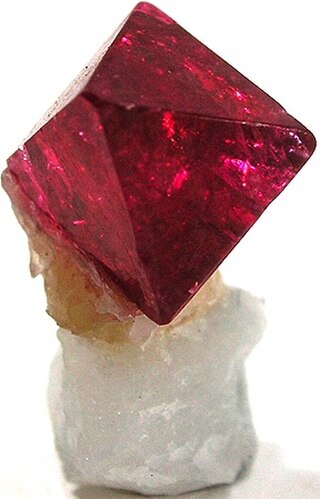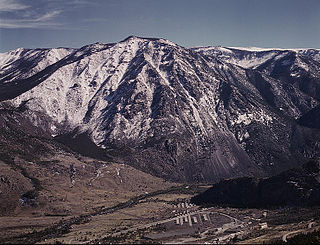
Chromium is a chemical element with the symbol Cr and atomic number 24. It is the first element in group 6. It is a steely-grey, lustrous, hard, and brittle transition metal.

Ore is natural rock or sediment that contains one or more valuable minerals concentrated above background levels, typically containing metals, that can be mined, treated and sold at a profit. The grade of ore refers to the concentration of the desired material it contains. The value of the metals or minerals a rock contains must be weighed against the cost of extraction to determine whether it is of sufficiently high grade to be worth mining, and is therefore considered an ore. A complex ore is one containing more than one valuable mineral.

Spinel is the magnesium/aluminium member of the larger spinel group of minerals. It has the formula MgAl
2O
4 in the cubic crystal system. Its name comes from the Latin word spinella, which means spine in reference to its pointed crystals.

Kimberlite is an igneous rock and a rare variant of peridotite. It is most commonly known to be the main host matrix for diamonds. It is named after the town of Kimberley in South Africa, where the discovery of an 83.5-carat (16.70 g) diamond called the Star of South Africa in 1869 spawned a diamond rush and the digging of the open-pit mine called the Big Hole. Previously, the term kimberlite has been applied to olivine lamproites as Kimberlite II, however this has been in error.

Dunite, also known as olivinite, is an intrusive igneous rock of ultramafic composition and with phaneritic (coarse-grained) texture. The mineral assemblage is greater than 90% olivine, with minor amounts of other minerals such as pyroxene, chromite, magnetite, and pyrope. Dunite is the olivine-rich endmember of the peridotite group of mantle-derived rocks.

Chromite is a crystalline mineral composed primarily of iron(II) oxide and chromium(III) oxide compounds. It can be represented by the chemical formula of FeCr2O4. It is an oxide mineral belonging to the spinel group. The element magnesium can substitute for iron in variable amounts as it forms a solid solution with magnesiochromite (MgCr2O4). A substitution of the element aluminium can also occur, leading to hercynite (FeAl2O4). Chromite today is mined particularly to make stainless steel through the production of ferrochrome (FeCr), which is an iron-chromium alloy.

Peridotite ( PERR-ih-doh-tyte, pə-RID-ə-) is a dense, coarse-grained igneous rock consisting mostly of the silicate minerals olivine and pyroxene. Peridotite is ultramafic, as the rock contains less than 45% silica. It is high in magnesium (Mg2+), reflecting the high proportions of magnesium-rich olivine, with appreciable iron. Peridotite is derived from Earth's mantle, either as solid blocks and fragments, or as crystals accumulated from magmas that formed in the mantle. The compositions of peridotites from these layered igneous complexes vary widely, reflecting the relative proportions of pyroxenes, chromite, plagioclase, and amphibole.

Uvarovite is a chromium-bearing garnet group species with the formula: Ca3Cr2(SiO4)3. It was discovered in 1832 by Germain Henri Hess who named it after Count Sergei Semenovitch Uvarov (1765–1855), a Russian statesman and amateur mineral collector. It is classified in the ugrandite group alongside the other calcium-bearing garnets andradite and grossular.

Pyroxenite is an ultramafic igneous rock consisting essentially of minerals of the pyroxene group, such as augite, diopside, hypersthene, bronzite or enstatite. Pyroxenites are classified into clinopyroxenites, orthopyroxenites, and the websterites which contain both types of pyroxenes. Closely allied to this group are the hornblendites, consisting essentially of hornblende and other amphiboles.

Lherzolite is a type of ultramafic igneous rock. It is a coarse-grained rock consisting of 40 to 90% olivine along with significant orthopyroxene and lesser amounts of calcic chromium-rich clinopyroxene. Minor minerals include chromium and aluminium spinels and garnets. Plagioclase can occur in lherzolites and other peridotites that crystallize at relatively shallow depths. At greater depth plagioclase is unstable and is replaced by spinel. At approximately 90 km depth, pyrope garnet becomes the stable aluminous phase. Garnet lherzolite is a major constituent of the Earth's upper mantle. Lherzolite is known from the lower ultramafic part of ophiolite complexes, from alpine-type peridotite massifs, from fracture zones adjacent to mid-oceanic ridges, and as xenoliths in kimberlite pipes and alkali basalts. Partial melting of spinel lherzolite is one of the primary sources of basaltic magma.

The Bushveld Igneous Complex (BIC) is the largest layered igneous intrusion within the Earth's crust. It has been tilted and eroded forming the outcrops around what appears to be the edge of a great geological basin: the Transvaal Basin. It is approximately 2 billion years old and is divided into four different limbs: the northern, southern, eastern, and western limbs. The Bushveld Complex comprises the Rustenburg Layered suite, the Lebowa Granites and the Rooiberg Felsics, that are overlain by the Karoo sediments. The site was first publicised around 1897 by Gustaaf Molengraaff who found the native South African tribes residing in and around the area.

A layered intrusion is a large sill-like body of igneous rock which exhibits vertical layering or differences in composition and texture. These intrusions can be many kilometres in area covering from around 100 km2 (39 sq mi) to over 50,000 km2 (19,000 sq mi) and several hundred metres to over one kilometre (3,300 ft) in thickness. While most layered intrusions are Archean to Proterozoic in age, they may be any age such as the Cenozoic Skaergaard intrusion of east Greenland or the Rum layered intrusion in Scotland. Although most are ultramafic to mafic in composition, the Ilimaussaq intrusive complex of Greenland is an alkalic intrusion.

Cumulate rocks are igneous rocks formed by the accumulation of crystals from a magma either by settling or floating. Cumulate rocks are named according to their texture; cumulate texture is diagnostic of the conditions of formation of this group of igneous rocks. Cumulates can be deposited on top of other older cumulates of different composition and colour, typically giving the cumulate rock a layered or banded appearance.

Fractional crystallization, or crystal fractionation, is one of the most important geochemical and physical processes operating within crust and mantle of a rocky planetary body, such as the Earth. It is important in the formation of igneous rocks because it is one of the main processes of magmatic differentiation. Fractional crystallization is also important in the formation of sedimentary evaporite rocks.

Harzburgite, an ultramafic, igneous rock, is a variety of peridotite consisting mostly of the two minerals olivine and low-calcium (Ca) pyroxene (enstatite); it is named for occurrences in the Harz Mountains of Germany. It commonly contains a few percent chromium-rich spinel as an accessory mineral. Garnet-bearing harzburgite is much less common, found most commonly as xenoliths in kimberlite.

In geology, an igneous intrusion is a body of intrusive igneous rock that forms by crystallization of magma slowly cooling below the surface of the Earth. Intrusions have a wide variety of forms and compositions, illustrated by examples like the Palisades Sill of New York and New Jersey; the Henry Mountains of Utah; the Bushveld Igneous Complex of South Africa; Shiprock in New Mexico; the Ardnamurchan intrusion in Scotland; and the Sierra Nevada Batholith of California.

The Merensky Reef is a layer of igneous rock in the Bushveld Igneous Complex (BIC) in the North West, Limpopo, Gauteng and Mpumalanga provinces of South Africa which together with an underlying layer, the Upper Group 2 Reef (UG2), contains most of the world's known reserves of platinum group metals (PGMs) or platinum group elements (PGEs)—platinum, palladium, rhodium, ruthenium, iridium and osmium. The Reef is 46 cm thick and bounded by thin chromite seams or stringers. The composition consists predominantly of cumulate rocks, including leuconorite, anorthosite, chromitite, and melanorite.

The Stillwater igneous complex is a large layered mafic intrusion (LMI) located in southern Montana in Stillwater, Sweet Grass and Park Counties. The complex is exposed across 30 miles (48 km) of the north flank of the Beartooth Mountain Range. The complex has extensive reserves of chromium ore and has a history of being mined for chromium. More recent mining activity has produced palladium and other platinum group elements.
Potholes are frequently encountered during mining operations in the Bushveld Igneous Complex in South Africa. Two orebodies, the Upper Group 2 (UG2) and the Merensky Reef, host about 70% of the world's platinum group metals (PGM), and pose major extraction problems for the mining industry in their faults, dykes, joints, domes, iron-rich ultramafic pegmatoids, rolls and dunite pipes. The greatest mining problems, though, are presented by potholes.
The Thaba mine is an open cast mine in the northwestern Bushveld Igneous Complex of South Africa near Thabazimbi in Limpopo. The Thaba Mines proven chromitite reserves amount to 23.6 million tonnes of ore grading 43.6% chromium. The 23.6 million tonnes of ore contains 10.3 million tonnes of chromium metal.


















